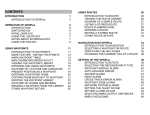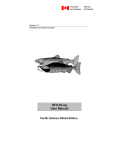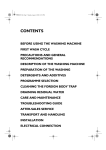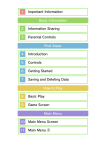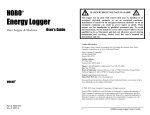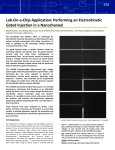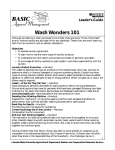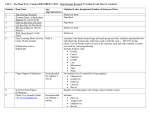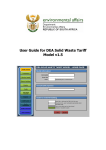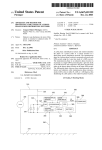Download Carrying the Cooper-Rand
Transcript
Table of Contents SUBJECT: Introduction Components Operating Instructions Speech Practice Telephone Use Talking to Children Care and Maintenance Batteries Cords Tubes & Tone Generator General Cleaning Institution Use Heat Dropping Carrying the Cooper-Rand Teach Someone to Help Contacting Luminaud Warranty Information PAGE 1 2 2 6 8 9 10 10 12 14 15 16 18 19 19 20 21 22 NOTE: The Serial Number of your Cooper-Rand is typed on the Decal inside the back cover. NOTE: We do not recommend using the Cooper-Rand in oxygen-enriched or explosive atmospheres. PAGE 1 Introduction The Cooper-Rand Electronic Speech Aid was developed by Dr. Herbert Cooper, head of the Cleft Palate Clinic in Lancaster, PA, and the Rand Development Corporation of Cleveland, which began production in 1957. Since 1972 it has been produced by Luminaud, Inc., owned and operated by Tom and Dorothy Lennox and family. Since laryngectomees and others unable to produce their own sound have the same needs today as they did in the 1950’s, the Cooper-Rand remains much the same as when it was originally designed: • It puts the sound directly into the mouth so there is no need for contact with the sensitive tissue of the throat. •Two-piece design allows the hand-held Tone Generator to be very light weight - just 1 oz. while the 7 oz. Pulse Generator is pocket size. • It provides an easy-to-use means of speech for immediate post-operative. • It makes a good long term back-up device for occasional or temporary use such as when esophageal or TEP speech is difficult due to illness or medical procedures or when fitted with a temporary trach tube. • It is a durable device for long-term use by those who cannot develop other means of speech and those who prefer its unique characteristics. Many Cooper-Rands produced over 20 years ago are still in daily use. • The Cooper-Rand’s unique design allows special adaptations for those who do not have good use of their hand and arms and those who must have both a voice and two free hands for their employment. PAGE 2 Cooper-Rand Components PAGE 3 Operating Instructions 1.Remove the Pulse Generator (PG) and the Tone Generator (TG), with cord attached, from the case. 2.Insert the connecting cord plug into the jack between the pitch and volume controls on the top of the PG. (see figure 2) 3.Set the pitch and volume controls about halfway around. PAGE 4 Operating Instructions (cont’d) 5.Pick up the Tone Generator with your non-dominant hand. Learn to use your non-dominant hand right from the beginning to keep your “good” hand free for writing, working, etc. (If you do not have full use of both hands and arms or must have a voice and both hands to use for work, contact us for information on our special Cooper-Rand adaptations.) 6. Insert the tube in the mouth and start to talk. (see “Speech Practice”) (see figure 3) 7.Adjust the pitch and volume controls for the best sounding voice. Get the advice of others since you do not hear yourself the same way listeners do. Some people find that shortening the tube a little gives them a voice they like better. You may want to experiment. You will need wire cutters to shorten the capped tube. PAGE 5 8.Experiment with using different fingers to push the TG button. Try the thumb, the finger tips or the first or second joints of the fingers for a comfortable, secure way to hold the TG without excessive touching of the cord. (see “Care and Maintenance, CORDS”) NOTE: Two types of tube come with the Cooper-Rand. The capped tube will hold its position better, and may help prevent intake of saliva or blocking of the sound by the tongue or cheek. The plain tube is softer, smaller and more flexible. You may find it more comfortable and that it allows easier shaping of words. Experiment with both and see which you prefer. PAGE 6 Speech Practice Though practice will be needed to achieve your best possible speech, you should be able to say words immediately and hold an understandable conversation the first day, if you follow these guidelines: 1)Insert about 1-1/2" to 2" of the plastic tube into the corner of your mouth. (see fig. 3) Make sure the end of the tube is above the tongue and pointed toward the roof of your mouth. Keep the tube toward the back above your tongue, leaving the tip of your tongue as free as possible. This allows you to shape words more easily and avoids the end of the tube being blocked by your tongue. 2)Press the button on the TG and try saying simple vowels: “A aa, E ee, I ii, O oo, U uu.” 3)Next try short, simple sounds, such as “Ma Ma” and “Da Da.” 4)Then count: “One, two, three, four, five, six,” etc. Do not hurry. 5)Tr y a few simple words or phrases, such as “How are you,” or “Mary had a little lamb.” Be careful to pronounce each syllable slowly and distinctly. Pay close attention to diction and pronunciation, exaggerating these at first. 6)Make your speech more understandable by using the TG button to turn the sound off and on between words, phrases or sentences. You will find that some sounds are more easily understood if the sound comes on just as you say them. Pinching the tube with your teeth at appropriate times can help shape and control certain sounds. Experiment and practice! PAGE 7 7)Practice with a recording device would be very helpful, leave messages on your phone answering machine so you can listen to yourself speak. 8)The assistance of a speech therapist would be very valuable in developing your best possible speech. It is especially important for those with tongue coordination problems or tongue muscle damage to have a therapist’s help. There are a few sounds which you will find difficult to make with the Cooper-Rand, such as the “ing” in “fishing.” Try saying “fishin” instead. A slightly sloppy sound will not be too hard to understand if most of your other sounds are clear. For words that are really difficult to say, substitute words of similar meaning that are easier to pronounce. If you wish to put inflection in your voice, adjust the pitch control as you talk. Some people have even learned to sing simple songs. Adjust the volume knob as loud or soft as necessary to be understood easily. While the Cooper-Rand will never give you the same quality speech you once had, self-consciousness will soon disappear with practice and most of what you say will be easily understood. PAGE 8 Telephone Use When on the phone, turn your volume down, as the telephone will distort your speech if the C-R volume is set too high. Hold the telephone mouthpiece up and away a little bit - this will reduce distortion. (see figure 6) Remember to speak extra slowly and carefully, as people cannot see your facial expressions and hand movements to help them understand what you’re saying. When giving your name and address to someone you don’t know, say three or four sentences first so the listener can begin to understand the pattern of your speech. Names and numbers are often hardest for others to understand because they get no clues from the rest of the sentence. Be extra careful with them. Practice on the phone with a friend or relative who can tell you what volume setting to use and which words are most difficult to understand. Work with an answering machine. Call and leave messages, then listen to them to adjust your settings and improve your pronunciation. PAGE 9 Talking to Children Children are more willing than adults to express their curiosity. Take advantage of this by showing them your Cooper-Rand and explaining how it works. You are likely to find that they are fascinated. One gentleman in his 80’s was frequently asked to teach Sunday School because the children were so interested in his Cooper-Rand. User Ted Harrison of Tennessee made up “A Frog Story” to help small children feel at ease with his Cooper-Rand. Here’s how it goes: Start at a medium pitch...” Once upon a time there was a big pond. On one side of it lived a great big bullfrog and across the pond on the other side lived a little tiny peep frog. On a warm, still night in the summer, the big bullfrog would holler across the pond to the little peep frog and say, ...” Put your pitch as low as it will go...” ‘Come over! Come over! Come over!’ And from across the pond the little frog would answer, ...” Here quickly run the pitch up high as possible... “ ‘Too deep! Too deep! Too deep!’ “ PAGE 10 Care and Maintenance BATTERIES 1. A set of batteries usually lasts about 4 to 6 weeks, but it may be a little less or a lot more depending on your use and preference. As the batteries are used, your sound will get weaker and lower pitched. The more you talk and the higher you have the pitch and volume set, the faster you will use up the batteries. NOTE: There is no need to adjust the pitch or volume setting or disconnect the cord when the C-R is not in use. The batteries are NOT being used unless the TG button is pushed in to produce sound. If your batteries last less than 2 1/2 weeks or give sub-stantially less service than usual without a reason (such as talking more due to a holiday guest), a repair may be needed. Send short lived batteries with your C-R for testing - it will help diagnose the problem - and the batteries may still be OK! 2. To replace the batteries, loosen the screw on the back of the case and remove the cover. Then remove one of the batteries by lifting the bottom end up with your finger or thumb and then keep lifting up at an angle until the battery snaps out. Repeat with the other battery. To insert new 9V. batteries: (figure 7A) Avoid doing dam-age to the snaps that hold the batteries in place by bracing the top of the clips with your fingers. Line a battery up carefully and squeeze the bottom of the battery with your thumbs until it snaps PAGE 11 snugly into place, as pictured below (7B). Repeat with the other battery. It is a good idea to use the same brand of battery each time if possible. The snaps on the tops of the batteries tend to differ just a bit in size from brand to brand, so if you change brands you might have to push really hard to get the batteries inserted or you might have to adjust the snap prongs in your Cooper-Rand to tighten them so they will make good contact. If your battery snaps get bent out too far so they do not make good contact or get bent over toward the middle of the snap so the batteries will not go in, you, or a local technician, should be able to adjust them with small pliers. If not, send the C-R to us. We recommend the use of good Alkaline batteries such as Eveready Energizer or Duracell. The so-called “Heavy Duty” or “Super” batteries are zinc, with much lower capacity. They usually last a much shorter time. After inserting the batteries, replace the cover. Do not over-tighten the cover screw as it may jam or bend the covers. If you have an older Cooper-Rand (Figure 7C) using 15 V. batteries (Eveready #411), you MUST BE SURE THAT BOTH BATTERIES ARE INSERTED WITH THE POSITIVE (+) TERMINAL UP as shown inside the back cover and in figure 7b. Any other position will RUIN the batteries and may damage the C-R. To tighten the clips, remove the batteries and GENTLY press the upper tabs, bending them down slightly. PAGE 12 Care and Maintenance (cont’d). 3. Keep one or more sets of new batteries on hand. Most modern batteries have a shelf life of a year or more, if they are stored properly in a cool, dry place. If your extra batteries will be kept for more than 2 or 3 months, or if the room temperature is over 70...F (21...C), store them in the refrigerator. Wrap them in waterproof material, but DO NOT FREEZE THEM! Let them reach room temperature and wipe off any moisture before inserting them in your C-R. CORDS 1. Cords can last a few weeks or over a year depending on how they are handled. DO NOT knot, kink or fold them, especially at the plug ends. DO NOT wind the cords tightly around the PG or put them under the clip. Experiment with your grip until you find a comfort-able position that will allow your cord to dangle free with very little hand contact. NOTE: We have several cord lengths available if the standard 40” is too long or short for you. 2. Leave the cord plugged in at all times until a new cord is needed. Frequent plugging and unplugging will reduce the life of the cord and may eventually damage the C-R’s contacts and connections. 3. If you want to disconnect the TG from the PG for ease of carrying, carefully unplug the cord at the PG end only. If you use more than one TG, each should have its own cord that is left plugged in. 4. If your sound goes off and on or stops, check to be sure that the cord is plugged in all the way. It sometimes can get bumped loose under the cord guard. If this doesn’t help, go on to next page, #5. PAGE 13 5. BROKEN CORDS ARE THE MOST COMMON CAUSE OF STOPPED OR INTERMITTENT SOUND! Cords can be broken even though there are no obvious cracks. To test a cord, hold the TG steady with the button pushed in. Wiggle the cord all along its length, especially at the TG end and in areas where there is obvious damage. If the sound goes off and on, the cord is broken and needs replacement. ALWAYS KEEP A NEW CORD ON HAND so you will be able to replace a broken cord immediately and won’t be left speechless. Throw away all broken cords. We do not repair them - the labor would cost more than replacing them. 6. Changing the Cord: Slide the cord guard back. Remove the old cord from the TG and the PG. Plug the new cord into the PG. Hold the TG with the button pushed-in and insert the tip of the prongs. Then pull the plug out, turn the plug over and insert the prong tips again. You will find that the sound is louder in one position. Choose that position and push the plug all the way in until you feel or hear a snap. BE SURE THAT ONE PRONG GOES IN THE SMALL ROUND HOLE IN THE PLASTIC PIECE AND ONE PRONG GOES BETWEEN THE PLASTIC PIECE AND THE SPRING WIRE. (see figure 8) (At the side of the opening, you may see a hole with a wire in it. DO NOT insert a prong into that hole. The wire is the connection to the switch and must not be damaged.) When the plug is in properly, slide the cord guard back over the plug. FIGURE 8. PAGE 14 Care and Maintenance (cont’d). TUBES AND TONE GENERATOR CARE 1. TUBES BLOCKED WITH SALIVA, FOOD OR BEVERAGES CAN WEAKEN OR STOP YOUR SOUND. Shake accumulating moisture from your tube frequently. If you use capped tubes, you must be particularly careful that the slots do not become plugged. 2. Tubes should be cleaned or replaced regularly. To clean and reuse the tubes, see “CLEANING - #3.” 3. Changing tubes requires a bit of wiggling and twisting. If using a capped tube, it may help to warm the end with a mild heat source such as a hair dryer or hot water. Be sure the tube is dry before putting it on. 4. Food, medicine, sugary or alcoholic beverage and unusually acid saliva can cause serious damage to the interior of the TG in just a few days. THIS DAMAGE IS NOT COVERED UNDER WARRANTY. To avoid it, shake accumulating moisture from your tube frequently - before it runs down into the TG interior -and rinse your mouth whenever possible after eating, drinking, taking medicine or smoking before using your Cooper-Rand. Acid and excessive saliva are often temporary problems caused by health, diet or medicine. Your doctor may be able to help or advise you. 5. Moisture accumulation: if your TG has collected so much moisture your sound becomes muffled or stops, remove the tube and shake it and the TG out. DO NOT try to swab out the interior of the TG as that may damage it. Then put the TG on its side in a warm place, such as the top of the refrigerator or TV. A day or so of drying may correct the problem. If not, it will need to be sent in for repair. You may want to have a spare TG so that you can use one while another is drying. PAGE 15 6. C-R moisture filters may be helpful to those who have a major or continuing problem with saliva, food, beverage or medicine getting into the TG 7. Nightly care: Do not pack your TG away at night. Leave it on its side in the open air so that any moisture inside can dry. However, very high humidity or chemicals in the air can be a problem. If you use a vaporizer or are in an area with salt sea spray, protect your Cooper-Rand by putting it in a plastic bag or other air-tight container overnight or when not in use for long periods of time. CLEANING 1. ALWAYS BE SURE YOUR HANDS ARE CLEAN AND DRY WHEN HANDLING THE COOPER-RAND. Accumulated moisture, dirt or food from your hands could cause the TG button to stick, corrode the switch contacts, or interfere with the movement of the pitch and volume controls. DO NOT OIL THE BUTTON OR ANY PART OF THE C-R. 2. Exterior surfaces of all parts should be cleaned as needed with a cloth slightly dampened in mild disinfectant such as Lysol or alcohol. The insides and edges of the covers and the grooves in the frame where the covers fit in can also be cleaned. DO NOT spray cleaners, disinfectants or lubricants into any opening in any part of the C-R. 3. Tubes - Remove the tube from the TG and wash it with hot water and soap. If a capped tube is used, brush out the slots. Rinse and allow to dry thoroughly before re-using. Tubes may be boiled or bleached if you wish. The plastic may whiten and the capped tube’s wire may rust a little, but this will not affect the use of the tubes or the TG. Clean pipe cleaners are very handy. PAGE 16 Care and Maintenance (cont’d). for cleaning and drying tubes, but NEVER insert a pipe cleaner or anything else into the opening in the stem of the TG - you might damage the transducer. 4. DO NOT spray or immerse the Cooper-Rand in liquid or cleaning solution. DO NOT run it through an Autoclave. Cold gas sterilization of all parts is acceptable if temperatures do not exceed 135....F. (57...C) • If the PULSE GENERATOR has gotten wet with beverage, salt water, muddy water, urine, etc., unplug the cord and put the TG aside. Remove both covers and the batteries and rinse all parts of the PG thoroughly under clear tap water. Wipe the covers and battery dry, shake out as much moisture as possible from the circuit board and allow to air dry for a day. • If the TONE GENERATOR gets wet inside with a foreign substance, DO NOT try to rinse it or clean it out - you may do more damage. Remove the tube, shake as much moisture out as possible from the TG and allow it to dry. If the sound is not satisfactory, it will have to be sent in for cleaning or repair. INSTITUTION USE When the Cooper-Rand is going to be passed on to a new user but there has been no contamination by major communicable disease, the exterior surfaces of the device should be cleaned as per the instructions and the tube should be thrown away and replaced with a new tube clean from the package. When an instrument is passed back and forth among therapists and patients for instruction, speech practice and temporary use, each user should have a personal tube, kept clean as one would clean eating utensils, and stored in an individual plastic bag or else a clean tube should be taken fresh from the PAGE 17 package. When the twists of the cord and the strain relief area become grimy beyond reasonable cleaning, the cord should be replaced. If using a filter holder and filters to protect the C-R interior from accidental damage from saliva and beverage, the individual foam filter pellets may be rinsed in a disinfectant solution, dried and reused until the foam begins to break up, at which time they must be discarded. Alternatively, they may be discarded and replaced as appropriate. The filter holder may be removed from the C-R Tone Generator and the two parts rinsed in disinfectant - or the parts may be washed or boiled, but they would not stand up to the heat of an autoclave. If needed, the filter holder parts may be included with the rest of the Cooper-Rand in the “cold gas” sterilization process - see next paragraph. For cleaning after serious contamination, such as by staph or strep, we recommend the procedure commonly referred to as “cold gas (ethylene oxide) sterilization.” The cooper-Rand should be opened, the tube and cord discarded, the batteries removed and the Tone Generator, covers, and frame/circuit board processed as separate pieces. Temperatures up to 135....F. (57...C) should not damage the Cooper-Rand or void the warrantee. (Note: The only thing affected by any temperature up to 135....F. might be battery life if you choose to clean the batteries rather than disposing of them. The higher the heat above room temperature and/or the longer the exposure to heat, the shorter the subsequent life of the batteries.) We cannot give information on exact sterilization procedure or personally state that this treatment will completely get rid of all the “bugs” as we are not able to do this kind of testing and experimentation ourselves. However, we do know that many hospitals routinely use this type of sterilization with what we assume are. PAGE 18 Care and Maintenance (cont’d). standard methods. Apparently this is quite satisfactory, as we have never had a report of any problems in the 30+ years that we have been manufacturing the Cooper-Rand. To keep the Cooper-Rand clean in difficult situations when you know that some deposit of foreign material or some degree of contamination will be likely, you may wish to consider encasing the Pulse Generator (battery and circuitry part) of the Cooper-Rand in a bag of soft but non-permeable plastic, such as polypropylene or mylar - NOT polyethylene - or in the hand of an examination glove. Use tape, a twist tie or etc. so that the material is gathered as closely as possible around the cord. To prevent damage and contamination in the button and switch area of the Tone Generator, wrap plastic around the Tone Generator or use a condom or an examination glove, making only a small opening where necessary for the tube and close the open end around the cord with tape or a twist tie. The button can be pushed easily even though it is under a soft material. Gloves or suitable covering materials are probably immediately available within your facility or should be obtainable from any company selling hospital lab supplies. Tubes and cords can be discarded and replaced as appropriate from your stock of Cooper-Rand supplies ordered from Luminaud, Inc. or one of our dealers. HEAT Heat over 135...F (57...C) may damage the transistors and shorten the battery life. Therefore, do not leave your Cooper-Rand in a car glove compartment, on a car dashboard, next to air conditioner coils, stove burners, hot water pipes, etc. PAGE 19 DROPPING DROPPING YOUR C-R may loosen the battery clips or do damage that will mean a costly repair. To tighten battery clips, see #2, pg. 10. If you have a problem with frequent dropping, find a way to prevent it! A safety chain or cord may be attached to your cover clip or run through one of the curls on the cord guard, then put around your neck or around your belt or pinned to your clothing. Or sew Velcro patches in your shirt pockets and place the matching pieces on the PG or TG. Or use a C-R carry case. Also see below. Carrying the Cooper-Rand The Cooper-Rand is most often carried by men with the PG in one breast pocket and the TG in the other breast pocket, with the cord around the back of the neck. Since shirts with two pockets are hard to find, try looking for Western wear, which is most likely to have them - or consider making a second pocket from the lower part of your shirt tail. The missing piece can be replaced with other fabric, since it isn’t seen. To shirts without pockets, add pockets (and possible collar and cuff trim) of a contrasting material. Or, clip the PG to tabs of fabric you have fastened to your clothes. You may need some reinforcing material in the area where the PG would be clipped. Another common way to wear the C-R is clipped to the belt or in the pants pocket with the cord around the back of the neck and the TG hanging down into a breast pocket. One of the longer cords may be needed for this. Or you might clip the Pulse Generator to a chain, necklace or cording around the neck. Women may be able to clip the PG to their underclothes. You may run. PAGE 20 Carrying the Cooper-Rand (cont’d). a fine chain or cord through one of the curls in the cord guard so you can hang the TG around your neck or pin it to your shoulder. Some customers report making holders for their TG by using a cut-off pen cap clipped inside a pocket. The TG tube can then be dropped into the cap when not in use. Others glue a piece of Velcro~ to the side of the TG or cord guard, and then glue the mating piece to the side of the PG. Then the TG can be “hung up” on the PG. A soft, padded carrying case for the Cooper-Rand may be ordered from Luminaud. Small camera or calculator cases or evening purses can also be used as carrying cases. Many large purses have outside pockets which also work well. If you have any suggestions on carrying the Cooper-Rand, let us know. We’ll be happy to pass them along. Teach Someone to Help Make sure those close to you can care for your Cooper-Rand, too. If you become ill, someone who doesn’t know Cooper-Rand care might put the cord or batteries in the wrong way or cause other problems. It could mean loss of the use of the C-R, inconvenience, sending for repair and extra expense just at the worst time. Don’t let this happen to you! Teach others about your Cooper-Rand so they can help you - and so they can show health care personnel how to help you. Many doctors, nurses and aides are not acquainted with the Cooper-Rand and will not be able to assist you with it unless taught. PAGE 21 CONTACTING LUMINAUD PLEASE CONTACT US IF YOU HAVE ANY PROB-LEMS OR ANY QUESTIONS OR WANT TO ORDER REPLACEMENT SUPPLIES. Call 800-255-3408 or 440-255-9082, Fax 440-255-2250, e-mail: [email protected] or write to: Luminaud, Inc. 8688 Tyler Blvd. Mentor, OH 44060 Make sure that anyone who contacts us knows the CORRECT NAMES for all the parts of the Cooper-Rand. It will avoid misunderstandings and shipment of the wrong items. Remember when ordering cords to specify the length, when ordering tubes to specify the type - and if you need batteries for an original 15V. Cooper-Rand, be sure to mention that you want 15V. #411 batteries.. Warranty Luminaud, Inc. warrants the Cooper-Rand Electronic Speech Aid for two (2) years against defective workmanship or parts. The warranty is NOT a two year service contract. It does not cover normal replacement of batteries, cords and tubes, nor does it cover damage from dropping, moisture, the accumulation of dirt or foreign material, improper use or care, or unauthorized repair. Warranty is limited to repair or replacement, at our option, of the defective unit and compensation of your postage (see below). No other warranty is assumed or implied. If trouble develops that you cannot correct after studying your User’s Manual and the check list on the pink Care and Repair Sheet, please contact us for advice, or return the Cooper-Rand to Luminaud, Inc. Use the repair form on the pink sheet or include a letter with a description of the problem(s) you are having and your name, address and phone number or e-mail address inside the package with the Cooper-Rand. Send by insured Priority Mail or by UPS insured. We are not responsible for packages we do not receive. Repairs under warranty will be returned to you at no charge with compensation for your shipping expense at normal Priority Mail or UPS rates - not for 2nd Day or Next Day or delivery service rates. We try to do non-warranty repairs at as reasonable a rate as possible. Please return the enclosed registration card for our records. WE WISH YOU MANY YEARS OF HAPPY TALKING! LUMINAUD inc 8688 Tyler Blvd., Mentor, Ohio 44060 Ph.: 800-255-3408, 440-255-9082, Fax: 440-255-2250 www.luminaud.com • e-mail: [email protected].
























